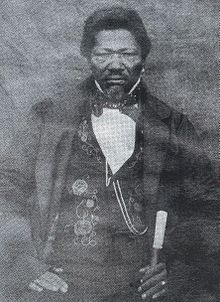
Back Griekwas (stam) Afrikaans Грыква Byelorussian Griqua Catalan Griqua Danish Griqua German Grikvoj Esperanto Griquas French Orang Griqua ID 그리콰인 Korean Griekwa Dutch
Griekwa | |
|---|---|
 Adam Kok III The Captain of the Griqua people | |
| Total population | |
| 775,000 Coloured Afrikaans outside the Cape | |
| Regions with significant populations | |
| South Africa, Namibia | |
| Languages | |
| Xiri[1] | |
| Religion | |
| Christian Protestant denominations, particularly Dutch Reformed Calvinist | |
| Related ethnic groups | |
| Coloureds, Khoikhoi, Basters, Oorlam, Afrikaners, Tswana, Xhosa |
Griqua People also known as Griekwa, Chariqua, Korana or Koranna can be found in South Africa and Namibia, they are related to the Khoisan People.The name Griqua (Griekwa in Afrikaans) is of Khoekhoe origin. The kind Griqua representative Thys Mentoor (interview, March 6, 2009) explained the significance of the ethnonym in his mother tongue Afrikaans:
"Grie beteken mense and "kwa beteken ook mense.[2] The Griquas are a unique ethnic group of Southern Africa. They are South Africa's first multiracial nation.[3][4]
The Griquas are a subgroup of mixed-race heterogeneous former Xiri languages [1]-speaking nations in South Africa with a unique origin in the early history of the Dutch Cape Colony.[5] The Griquas had ancestors from two groups: the Koks and the Barendse. The Koks were mostly Khoikhoi, and the Barendse were a mix of Khoikhoi and European people (Griqua | South African History Online).[6] These predominantly Khoi indigenous people were reclassified as "Coloured" in the 1950s by the apartheid government.[7] They undertook a migration away from the Cape colony, forming two "Griqua States" formerly known as Griqualand West and later Griqualand East. When the Boers and colonial masters came to what was then called Griqualand West, they stopped the Griquas from developing in the ways that they saw fit. Their land and native resources were taken away from them, and they were thrown into a sea of fast social change. This made them lose the freedom they had been looking for in the Orange Free State area. (Griqua | South African History Online) In 1826 a group of emigrants from Griquatown under Adam Kok II was allowed to settle at the mission station of Philippolis in the Transgariep. This became the capital of a new Griqua Captaincy, which for several decades was an important factor in the politics of the Northern frontier and the cause of the British Government first becoming involved in the affairs of the area (Schoeman, K, 2002).[8] Similar to the Trekboers[9][10] (another Afrikaans-speaking group of the time), they originally populated the frontiers of the nascent Cape Colony (founded in 1652). The men of their semi-nomadic society formed commando units of mounted gunmen. Like the Boers they migrated inland from the Cape and in the 19th century established several states in what is now South Africa and Namibia. Under the supervise of Adam Kok I, they held ceremonies celebrating the virginity of their young daughters. (Griqua people AFRICA/101 Last Tribes) The Griqua, who originated through the interracial marriages and relations between the KhoiKhoi people and the European Colonists, consider themselves as being South Africa’s first multiracial nation with people descended directly from Dutch settlers in the Cape, and local peoples.[11]
- ^ a b Rosenfelder, 2023
- ^ The Making of Griqua, Inc: Indigenous Struggles for Land and Autonomy in South Africa (Book) January 2015 SchweitzerE._GriquaInc._Excerpt.pdf
- ^ Afrika 101 Last Tribes, Griqua People. "Afrika 101 Last Tribes The Griquas could trace their forefathers to two clans, the Koks and Barendse, the first made up mainly of Khoikhoi and the second of mixed European descent". Afrika 101 Last Tribes. Retrieved 5 May 2024.
{{cite web}}: CS1 maint: numeric names: authors list (link) - ^ "Africa 101 Last Tribes". Africa 101 Last Tribes. Retrieved 5 May 2024.
- ^ "Griqua | South African History Online". www.sahistory.org.za. Retrieved 30 May 2020. Text was copied from this source, which is available under a Creative Commons license.
- ^ Griqua | South African History Online (sahistory.org.za)
- ^ Waldman, Linda (2 December 2006). "Klaar Gesnap As Kleurling:1 The Attempted Making and Remaking of the Griqua People". African Studies. 65 (2): 175–200. doi:10.1080/00020180601035633. S2CID 144687031.
- ^ Schoeman, Karel (9 May 2024). The Griqua Captaincy of Philippolis 1826-1861. Protea Book House. ISBN 9781919825397.
- ^ Cite error: The named reference
:3was invoked but never defined (see the help page). - ^ [1]Landau, Paul S. (2010). "Mixed People (The Samuelites, the Griqua, and other subjectivities, 1880–1928)". Popular Politics in the History of South Africa, 1400–1948. Cambridge: Cambridge University Press. pp. 162–213. doi:10.1017/cbo9780511750984.006. ISBN 978-0-511-75098-4.
- ^ Mildred Europa Taylor January 28, 2021
© MMXXIII Rich X Search. We shall prevail. All rights reserved. Rich X Search